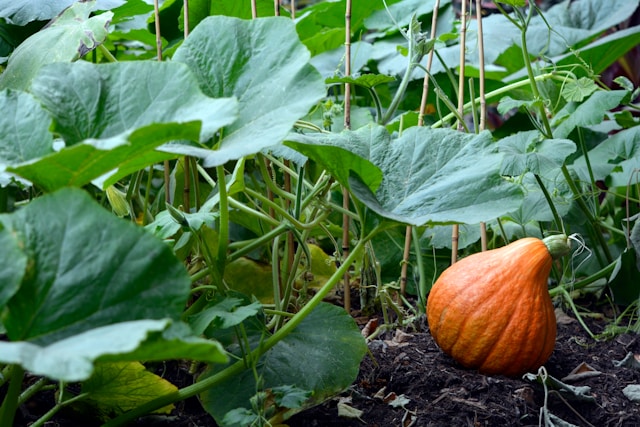As the world of agriculture continues to evolve, so too does the regulatory landscape surrounding it.
It is an undeniable truth that policies play a crucial role in the success and shortcomings of any industry.
Agriculture, more specifically produce agriculture, is no exception.
Major changes in policy can trigger a cascade of effects that might significantly reshape the sector.
This article will explore recent adjustments in policies and their potential impact on the growers and distributors in the industry.
Understanding these changes is vital for future sustainability and growth in the evolving sphere of produce agriculture.
Contents
- Policy Changes Affecting Produce Agriculture
- 1. Changes in immigration policies affecting farm labor supply
- 2. Increased Environmental Regulations on Pesticide Use
- 3. Introduction of genetically modified crop policies.
- 4. Changes in land use and zoning laws
- 5. New Policies on Organic Farming Standards
- 6. Updates in International Trade Agreements
- 7. Modifications in Farm Subsidy and Support Programs
- 8. Enhanced Water Usage and Irrigation Regulations
- 9. Increased food safety and quality standards.
- 10. Implementation of Climate Change Mitigation Policies
- The Bottom Line
Policy Changes Affecting Produce Agriculture
1. Changes in immigration policies affecting farm labor supply
The agricultural industry, especially the field of produce agriculture, has long relied on foreign labor, mainly migrants, to meet its significant labor requirements.
However, recent changes in immigration policies have begun to dramatically affect the labor supply.
In many countries, stringent immigration laws and regulation have reduced the influx of migrant labor.
These restrictions on immigration have consequently led to a significant labor shortage in the produce agriculture sector.
The high demand for labor, combined with this decrease in supply, has increased labor costs immensely for agricultural producers.
Some farms have had to cut down on production or even shut down altogether because of labor shortages.
This, in turn, affects the overall affordability and availability of agricultural produce in the market.
On the other hand, some farm owners attempt to adapt by automating processes, thereby reducing dependency on human labor.
It is also important to note that for many migrant laborers, agricultural work represents a source of income and an opportunity for a better life.
Stricter immigration policies, therefore, not only affect farm productivity but also narrow the economic opportunities available to numerous migrant workers.
Moreover, labor shortages in agriculture can lead to a ripple effect on connected industries such as transport, storage, and retail.
The societal implications of these immigration policies are thus quite profound and extensive.
While it’s clear that changes in immigration policies have led to escalating farming costs, it’s also vital to understand the broader ramifications.
Considering the balance needed to maintain farm productivity, labor rights, and national security is necessary while formulating immigration policies that target foreign labor supply in agriculture.
Overall, the impact of changing immigration policies should be assessed not just from a labor supply perspective, but also from a broader socio-economic viewpoint.
Any solution to this issue must thus involve careful deliberation and a comprehensive understanding of all competing interests.
2. Increased Environmental Regulations on Pesticide Use
In recent years, policies pertaining to the environmental regulation of pesticide use have undergone significant changes.
The amended regulations have a profound impact on produce agriculture due to the sector’s reliance on pesticides for crop protection.
These policy changes can heighten compliance costs for farmers as they may necessitate the acquisition of new pest management solutions.
While the intent behind these regulations is to protect the environment and human health, they may inadvertently pose financial and operational challenges for farmers and agribusinesses.
The tightened regulations may also stimulate innovation in green pest management solutions as farmers and pesticide manufacturers scramble to develop and adopt environmentally-friendly alternatives to traditional pesticides.
For instance, biological pesticides and Integrated Pest Management (IPM) techniques are increasingly seen as viable options.
Stakeholders across the agriculture value chain, from growers to retailers, must understand and adapt to these new regulatory landscapes.
To stay compliant, many farmers have had to adjust their pest management practices, which includes the use and disposal of pesticides.
Several farmers have transitioned to less toxic pesticides or reduce their overall pesticide usage to comply with the new regulations.
These transitions, however, are not devoid of challenges as they often descend into costs and financial risks.
In some cases, farmers have had to engage the services of embedded experts to navigate the dense network of regulations and avoid non-compliance penalties.
Notably, the increased regulations have sparked debates around the sustainability of current farming practices and the need for more environmentally-conscious approaches.
Policies on pesticide use are becoming more stringent, not solely in developed countries but also across developing nations.
This could potentially introduce a level of standardization across global produce markets, as farmers and exporters universally adopt sustainable pesticide practices to meet international requirements.
Overall, while the increased environmental regulations on pesticide use pose certain challenges for the produce agriculture industry, it also highlights an urgent need to develop sustainable and environmentally-friendly farming practices.
The tightened rules underscore the fact that the long-term viability and sustainability of the agriculture sector are inextricably linked to the health of the environment and the broader ecosystem.
3. Introduction of genetically modified crop policies.
The introduction of genetically modified crop policies has significantly redefined the landscape of produce agriculture.
These policies have been instituted to manage the adoption and use of genetically modified organisms (GMOs) in farming.
Genetically modified crops have the potential to increase agricultural productivity and efficiency, enabling farmers to meet the increasing demand for food globally.
However, with their use comes several environmental, health, and economic concerns requiring regulation.
Formulating a balance between the benefits and potential risks involved in GMOs usage has been a significant challenge for policymakers.
GMO policies vary widely from one country to another, shaped by each nation’s unique agricultural needs, environmental concerns, and public sentiment.
In some regions like the European Union, stringent laws have been enacted, restricting the planting and sale of genetically modified crops.
However, in countries like the United States and Brazil, these crops have been widely adopted with much less stringent regulations.
The process of policy formulation typically involves extensive risk assessment and stakeholder engagement to ensure that the benefits of GMOs outweigh potential risks.
This involves an evaluation of cross-pollination risks, potential impacts on non-target organisms, and the potential for pests to develop resistance to GMOs.
Beyond the farms, genetically modified crop policies also outline food labeling requirements to provide consumers with the choice of purchasing GMOs or not.
This reflects the understanding that consumer beliefs, misconceptions, or concerns about GMOs may influence food choices significantly.
To ensure the positive impact of GMO policies, constant review and updating of these policies is necessary to reflect current scientific advancements and public sentiment.
Policy changes concerning GMOs are likely to have far-reaching implications on the global food system, including aspects related to food security, farmers’ rights, and biodiversity conservation.
Indeed, developing balanced, comprehensive and effective genetically modified crop policies remains a complex challenge for policymakers, considering the diverse perspectives and vested interests involved.
4. Changes in land use and zoning laws
Land use and zoning laws are critical factors determining the trajectory of agriculture, especially produce farming.
Over time, many areas traditionally utilized for agriculture have experienced zoning changes, either to develop or conserve lands.
These changes, often intended to favor urban development or environmental conservation, can limit the availability of arable lands for farming produce.
As urban areas rapidly expand, the pressure to convert agricultural lands into residential, commercial, or industrial areas intensifies.
Zoning policies that deem agricultural lands as something to be replaced or discarded, not only decrease the quantity of land available for farms but can also raise the costs for those who aim to sustain or establish farms.
Notably, changes in zoning laws could result in higher real estate prices, putting farmland out of reach for many farmers, particularly smaller operators.
Even in regions where agricultural lands are protected, zoning amendments can impose additional restrictions, affecting what type of produce can be grown and how.
Some zoning laws even dictate the specific crops that can be cultivated in a given area. Such policies can force producers to change their crop cycles or grow less suitable or profitable crops.
Zoning laws also influence the infrastructure available to farms.
Farming, particularly produce farming, relies heavily on quality infrastructure, such as irrigation, processing, and transport facilities, which can be hindered by certain zoning rules.
There are instances, moreover, where zoning laws have unintended impacts on farm operations.
For example, some municipalities have zoning laws that unintentionally discourage water reuse or the adoption of certain innovative technologies in produce farms.
At the same time, it’s important to underline that while these changes can pose potential threats to produce agriculture, they can also provide new opportunities.
Sorted appropriately, zoning can preserve agricultural lands, limit damaging encroachment, and even promote local urban agriculture.
In conclusion, ongoing changes in land use and zoning laws continue to significantly shape the prospects of produce farming in diverse ways.
Therefore, these changes demand careful attention, proactive response, and innovative adaptation measures from everyone involved in produce agriculture.
5. New Policies on Organic Farming Standards
In recent years, a notable shift towards organic farming practices has been observed in agriculture worldwide.
This trend is a response to an increasing consumer awareness and demand for foods that are not only healthy but also produced in an environmentally sustainable manner.
Accommodating this shift, several new policies on organic farming standards have been introduced by governments and relevant bodies.
Farmers who adhere to these organic farming practices can receive organic certification, enabling them to market their produce at a premium price.
The shift to organic farming often demands a complete overhaul of existing farming practices and systems.
Through various stringent policies, governments are ensuring that organic labeling is not just a marketing gimmick but a reflection of a s farming process that respects nature, promotes biodiversity, and supports animal health and welfare.The recent policies on organic farming standards have presented both challenges and opportunities for farmers.
On one hand, complying with these standards can be expensive and labor-intensive.
Many farmers are finding it difficult to transition due to a lack of necessary infrastructure or financial resources.
On the other hand, these policies are creating a niche market for organic produce that offers significant financial incentives.
Organic farming policies not only affect farmers but also have implications for consumers, the agriculture industry, and the environment.
For consumers, these policies ensure that the organic products they purchase are genuinely organic, promoting trust in organic labeling.
They also promote the consumption of healthier foods, possibly leading to a decrease in health issues related to diet.
The agriculture industry, meanwhile, benefits from having a set of comprehensive, government-endorsed guidelines to follow.
This standardization helps to regulate the market and ensure fair competition among industry players.
For the environment, the implementation of organic farming policies is good news as these practices are often more sustainable and less polluting than traditional farming methods.
The rise in organic farming standards mirrors a global shift towards sustainable agriculture and is indicative of the significant role policy plays in shaping this industry.
6. Updates in International Trade Agreements
Recent policy shifts have brought about significant changes in international trade agreements, directly impacting produce agriculture.
Such changes can be seen on a global scale, affecting trade relations between varied countries.
The changes in international trade agreements can enhance or limit the export and import of agricultural products.
For example, if a country decides to place tariffs or restrictions on certain agricultural goods, this could significantly impact produce farmers.
Such modifications in trade policy can lower profits for farmers who rely heavily on exporting their goods.
On the other hand, if a country decides to lower barriers to certain imports, this could increase competition for domestic farmers.
Farmers in all countries must remain adaptable and responsive to these shifts in international trade policy.
Essentially, updates in international trade agreements are directly connected to the economic viability of the produce farming industry everywhere.
Trade agreements can also alter technological resources and farming practices internationally.
For instance, if a developed country negotiates a trade agreement with a developing nation, there may be technology transfers that could modernize farming practices in the developing country.
Produce farmers everywhere also need to meet the regulations of their target markets for export, and changes in trade agreements can affect these regulations.
This can necessitate changes in farming practices to comply with international standards.
Therefore, notwithstanding the potentially complex implications of changes in trade agreements, it underscores the role of policy change in shaping the trajectory of the agriculture industry.
Such policy changes may also have domino effects on other sectors, such as agricultural technology, transportation, and distribution, further emphasizing their importance.
Overall, it’s apparent that updates in international trade agreements are catalysts for change that can dramatically reshape the face of produce agriculture.
7. Modifications in Farm Subsidy and Support Programs
Policy changes impacting farm subsidies and support programs greatly influence the landscape of produce agriculture.
One of the most critical of these changes involves the restructuring of subsidy distribution where the primary beneficiaries become larger commercial farms over smaller family-run farms.
It is crucial to comprehend that such a transformation could destabilize small-scale agriculture, heightening risks associated with income and market uncertainties.
Another significant policy modification has been the shift towards decoupled subsidies, those not directly linked to current agricultural production.
Decoupled subsidies have the potential to afford farmers greater flexibility, enabling them to respond to market signals rather than policy dictates, which may lead to a more efficient and resilient agricultural sector.However, these subsidies also bear the risk of distorting global crop markets and undermining equity within the farming community.
Moreover, changes in support programs, such as disaster relief and crop insurance, can also exert considerable influence over agricultural practices.
It’s worth noting that, for instance, if these support programs become more risk-averse, it can discourage technological innovation and hinder sustainability efforts.
Policy modifications that prioritize green subsidies as a means to encourage sustainable farming practices represent another crucial development.
That said, the effective implementation of these policies depends heavily on the appropriate allocation of funds and regular monitoring for compliance.
On the other hand, policy changes that reduce farm subsidies altogether, in favor of a free-market approach, can have serious implications for the agricultural community.
Such reductions could leave farmers more exposed to market volatility, thereby increasing the financial risks associated with farming.
Importantly, these changes to farm subsidy and support programs do not occur in isolation; they must be considered within the broader context of agricultural policy and its interplay with other influential factors.
In reviewing these changes, it becomes evident that they can have profound implications, reshaping the very fabric of produce agriculture.
Whether these implications are always beneficial or whether they serve as impediments to the growth and sustainability of the agricultural sector varies.
Inevitably, these policy changes require attentive, ongoing evaluation to ensure that they promote a resilient, productive, and sustainable agricultural sector.
The challenge for policymakers is to strike a balanced approach where these changes secure the livelihoods of farmers while also ensuring a sustainable and reliable food supply.
8. Enhanced Water Usage and Irrigation Regulations
Climate change and the increasing global population present a significant challenge in water management, necessitating enhanced water usage and irrigation regulations.
As a result of policy changes in water regulations, farmers are now required to implement sustainable water practices to conserve water resources.
One way to achieve the conservation of water resources is through the efficient use of irrigation systems.
The implementation of smart technology in irrigation systems like smart sprinklers and drip irrigation systems ensures the precise distribution of water to the crops, thus conserving water.
The use and development of these efficient irrigation systems have been encouraged by government policies which provide financial incentives to farms that adopt them.
The changing policies also demand water rights permits for any water usage for irrigation purposes.
This has led to farmers investing in more efficient methods of irrigation, but it also puts a financial strain on small-scale farmers who can’t afford these high-tech systems.
A consequence of these strict regulations is that some farmers have been forced to rely on rain-fed agriculture, which is highly uncertain and risky due to unpredictable weather patterns.
Nonetheless, the policy changes are not just about restricting water usage but also about promoting water conservation practices.
This includes practices such as cover cropping and crop rotation which aim to maintain soil moisture and reduce the need for artificial irrigation.
Farmers are also encouraged to apply organic mulching, a farming technique that retains soil moisture, thus reducing the frequency of irrigation.
While these modifications in water usage and irrigation policies may seem stringent, the aim is to ensure that agriculture remains sustainable amidst the dwindling fresh water resources globally.
The policies also aim to safeguard against water pollution often as a result of agricultural runoffs, thus protecting both the environment and human health.
Furthermore, these water usage regulations take into account the rights of downstream users and aim to promote fair distribution of water resources.
Lastly, it is important for the policymakers to consider the economic implications of these regulations on the agricultural industry, especially the small-scale farmers who can’t afford the cost of high-tech irrigation systems.
Therefore, the policy changes necessitate that all stakeholders in the agricultural industry adapt to new and efficient ways of irrigation that not only conserve water but also make the sector resilient and sustainable.
9. Increased food safety and quality standards.
Over the years, legislative changes in many countries worldwide have increased food safety and quality standards that affect produce agriculture.
It has been a response to the rising concerns over foodborne diseases and the health impacts of pesticide residue in food.
Such policy shifts render a significant effect on the farming sector, particularly those who grow fruits, vegetables, and other fresh produce.
Increased food safety and quality policies directly compel farmers to strictly adhere to stringent regulations, fostering a safer, cleaner, and more health-conscious food industry.These changes often mandate farmers to employ more rigorous safety measures and hygiene protocols throughout their farming processes.
For instance, practices like regular testing for contaminants, recording keeping for traceability, and maintaining facilities to reduce the risk of product contamination have become standard requirements.
Moreover, these policy changes have also driven a widespread shift towards the adoption of More Sustainable and Organic Farming Practices.
Produce farmers are strongly encouraged, if not required, to use fewer chemical pesticides and synthetic fertilizers, promoting soil health, biodiversity, and overall sustainability.
Furthermore, the policy-induced increase in food safety and quality standards often lead to higher Costs of Production for farmers.
They could involve investment in new machinery, payment for third-party inspections, or increased labor costs associated with implementing and maintaining the required safety measures.
Yet, it’s also worth noting that these changes also bring about certain benefits to produce farmers.
By implementing higher safety and quality standards, farmers could strengthen consumers’ trust, expand their customer base, and tap into premium markets that value high-quality, safe and sustainably grown produce.
On a larger scale, these policies indirectly contribute to the global efforts to achieve Sustainable Development Goals, particularly in ensuring healthy lives and promoting the wellbeing for all.
However, successful adoption of such stringent standards heavily depends on the level of support received from key stakeholders, including governments, extension services, and international trade partners.
Better education, financial supports, and capacity building programs are fundamental for farmers to satisfy the increased food safety and quality standards while ensuring the economic sustainability of their farming business.
Moving forward, it’s crucial that future policy changes regarding food safety and quality standards need to be carefully crafted and thoughtfully implemented, taking into account their multifaceted impacts on produce farms and farmers, consumers, and the environment as a whole.
10. Implementation of Climate Change Mitigation Policies
The implementation of climate change mitigation policies has significant influence on the produce agriculture sector.
With rising global temperatures, producing certain types of crops is becoming more difficult, therefore, these changes are necessary and directly impact produce agriculture.
The emphasis on sustainable farming practices, brought on by these policies, is shaping the ways many farms operate.
The move towards carbon-neutral farming is one translated implication of these mitigation policies.
Farmers are now required to implement practices that reduce carbon emission, contributing to the overall global effort to mitigate climate change.
The development and promotion of precision agriculture also serves as an adaptation to climate change conditions.
This new farming approach involves using technology to improve efficiency and reduce waste, in turn decreasing its environmental impact.
New technology such as remote sensing and monitoring, GPS tracking, and computer-controlled equipment are all contributing to a more sustainable and efficient farming practice.
Another policy change relates to the promotion of climate-smart agriculture.
This aims to help farmers adapt to the effects of climate change while also minimizing their environmental impact by emphasizing resilience and emission reductions.
In relation, there’s a growing emphasis on planting cover crops to safeguard against erosion and improve soil health, again, a policy revolving to mitigate climate change.
Policy changes also involve the incorporation of agroforestry practices, which involve growing trees alongside crops to increase carbon sequestration.
For certain regions, the drive towards a diversified farming system is being prioritized to increase the resilience of the system against changes in climate.
Moreover, crop variation techniques are being promoted to prevent the over-reliance on any one crop, ensuring a continuous supply even during adverse climate conditions.
Overall, these policies are pushing for the agriculture industry to adopt more sustainable practices to mitigate the impacts of climate change.
However, it’s important to point out that implementing these climate change policies often require significant investment in technology and infrastructure, and this could impact profitability especially for small farmers.
The cost and financial risk of transitioning to these sustainable practices is, therefore, a pertinent issue, and policies need to take this into account to ensure equitable transformation across all farming scales.
The Bottom Line
Our exploration of various policies reveals the vast complexity and breadth of factors that shape the agricultural industry today.
From immigration policies impacting labor supply to enhanced environmental, water usage, and irrigation regulations, farmers need to adapt and comply accordingly.
The refinements in international trade agreements, organic farming standards, food safety, and quality standards bear significant weight as well.
On another note, genetically modified crop policies and changes in land use and zoning laws present both challenges and opportunities.
Lastly, the imperatives of climate change are prompting essential structural changes within the industry, demanding innovative solutions and a transition towards more sustainable practices.
Thus, to remain viable and successful, farmers must be proactive and well-versed in navigating the changing policy landscape.
These insights underline the necessity for more robust support for farmers, particularly in the areas of technical training, access to resources, and the development of more resilient and sustainable farming systems.




